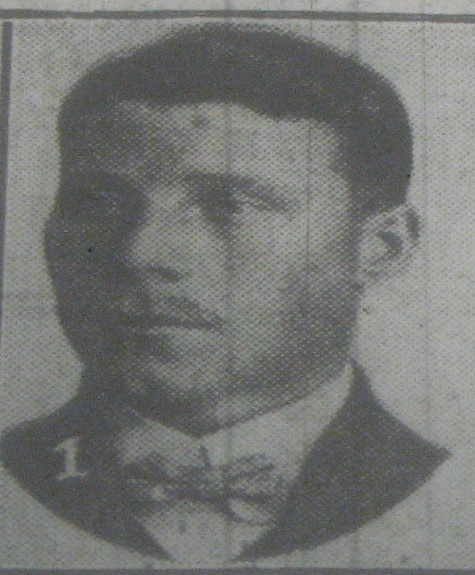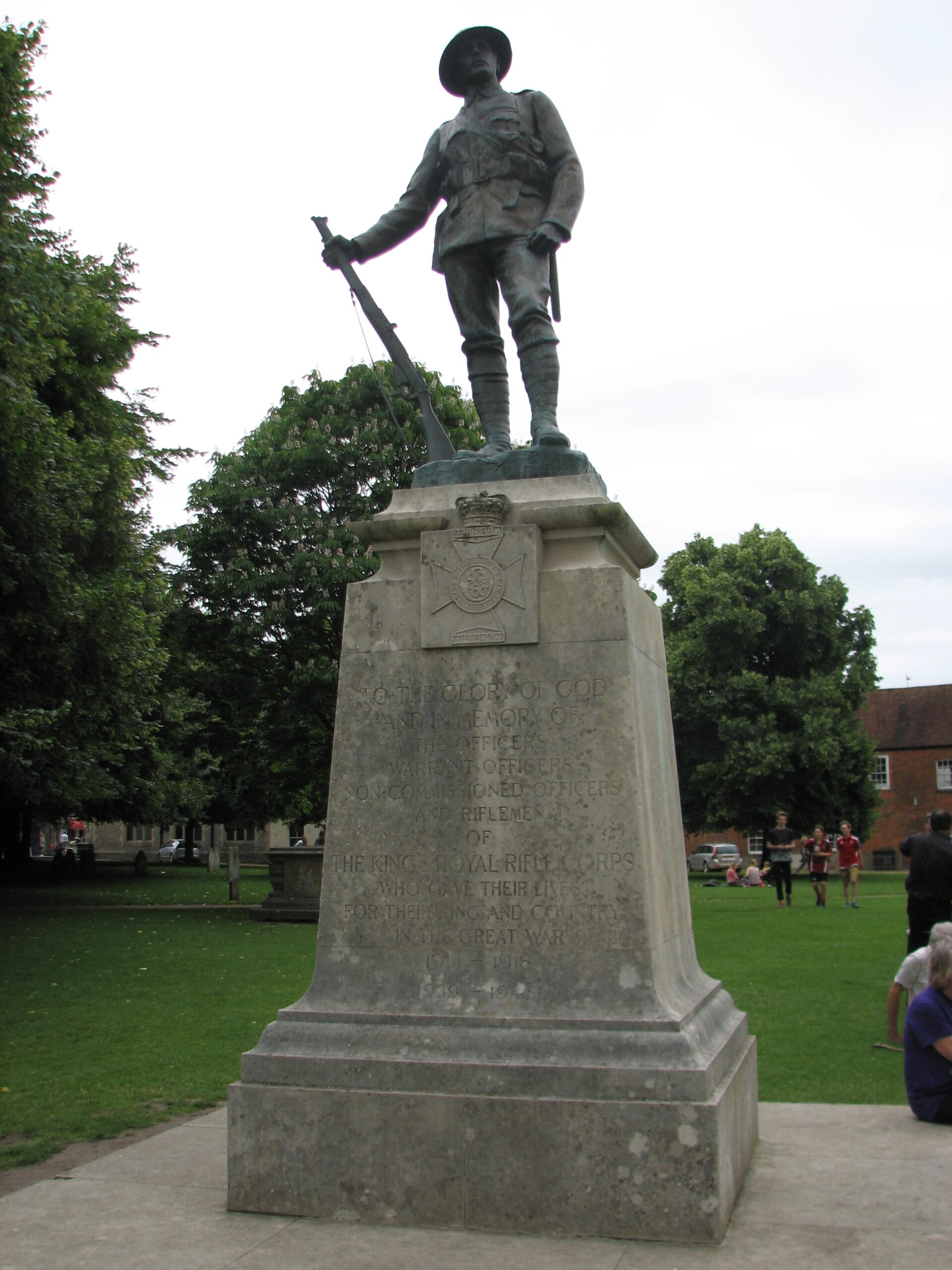William Southgate (1888 - 1916)
Brother of Frederick Southgate and Walter Southgate. A pre-war Regular in the King’s Royal Rifle Corps, William was later attached to the Indian Telegraph Department and served with them in Mesopotamia.
- 60
- Died in the Great War
- 51.974929, 1.055336
Details
| Name: | William Henry Southgate |
| Service: | British Army |
| Unit: | 4th Battalion, King’s Royal Rifle Corps (attached to Indian Telegraph Department) |
| Regimental Number: | 7869 (Ind. Tel. Dept. No. 478) |
| Rank: | Rifleman |
| Date of Death: | 1st July 1916 |
| Age: | 27 |
| Commemorated: | Panel 30, Basra Memorial, Iraq |
Three East Bergholt families each lost three of their sons during the Great War. For one of those families – the Southgate family, from East End – this meant the loss of all three of their children.
Family Background and Early Life
William Henry Southgate was born at Chapel Court – which used to stand adjacent to the Holy Trinity Churchyard off Fore Hamlet – in Ipswich, on 30th July 1888; the first child of Sarah Southgate, a Housekeeper.
William and his mother later moved to Upper Orwell Courts in the town, where Sarah’s second child Frederick, was born in early January 1891. Sarah’s occupation on Frederick’s birth certificate is given as a Sack Mender for a Corn Merchant, though on the 1891 Census – conducted in March of that year – she is listed as a Servant.
Sarah and her two sons later moved to Lawford, where she was employed as a Housekeeper. There, in October 1896 she gave birth to a third son called Walter.
The following year, the family moved to Burnt Oak in East Bergholt. William and Frederick started at the village school – which at that time was situated at Burnt Oak Corner, on 27th September.
Sarah was acting as a live-in Housekeeper for a 45 year old widower, Frederick Dorman, and his twenty two year old son, Henry, who both worked at the Xylonite factory in Brantham.
William left Bergholt School in April 1901, just before his 13th birthday – the usual school leaving age at that time.
Joins the Army
In the following years William found work as a Labourer, and also joined the 2nd Volunteer Battalion of the Essex Regiment, which was part of the forerunner of the Territorial Army. Presumably, there were aspects of Army life which appealed to the young William, for on 7th January 1907, he joined up as a full-time soldier – enlisting at Ipswich, in the King’s Royal Rifle Corps (K.R.R.C.), under the name of Henry Southgate.
By the time of William’s enlistment, Frederick Dorman – along with Sarah and her sons – had moved to East End. They lived for a time on Mission Lane, before later moving around the corner to Rose Cottage, situated next to the “Dickie”. 1 Frederick Dorman and the Southgate family had moved to Rose Cottage by April 1911. The building still survives, though it is now just one residence rather than two as it was then.
William’s surviving Service Papers show him to have been 5 foot 3 inches tall at the time of his enlistment, weighing 8 stone 4 lbs, with a fresh complexion, light blue eyes and light brown hair.
William travelled to the K.R.R.C. Depot at Winchester: There, he officially became Rifleman Southgate, with the Regimental Number of 7869, and commenced his basic training. 2 Rifleman was the King’s Royal Rifle Corps equivalent rank to a Private. At the start of May – probably at the end of his basic training – William was posted to the Corps’ 3rd Battalion, at that time based at Aldershot.
Crete and Malta
Rifleman Southgate received his first posting overseas in February of the following year, when he was sent to Candia (modern day Heraklion) on the island of Crete. He was there, as part of the international military force, made up of contingents from Italy, Russia, France and the United Kingdom. Their forces had been garrisoned on Crete for the last ten years as part of an agreement to establish peace between Greece and the Ottoman Empire, who had been in dispute over the island.
William’s service on Crete lasted until the end of July, when he was posted to Malta – at that time an important part of the British Empire, being a fleet headquarters and key stopping point on the route to India. William was to remain on Malta until February 1909, when he was posted to the Corps’ 2nd Battalion in India.
India
India was at that time considered to be “the jewel in the crown” of the British Empire, and the United Kingdom had a major military presence there. This presence took two main forms: one being the Indian Army which was “the force recruited locally and permanently based in India, together with it’s expatriate British officers”; 3 From “The Oxford History of the British Army”. the other was the British Army in India, which was made up of British Army units posted to India for a tour of duty, and which would then be posted back to the UK or other parts of the Empire.
It is perhaps easy to forget now, but India in the early twentieth century also included the areas which we now know as Pakistan, Bangladesh and Burma.
Jubbulpore (now Jabalpur) was to be William’s first station in India, and he arrived there on 12th February 1909. British troops stationed in India often suffered from a whole host of tropical diseases, and William was no exception: Whilst at Jubbulpore, he was hospitalised for over a week suffering from Malaria; in early 1910 – shortly after William’s transfer to the Corps’ 4th Battalion – he was again admitted to hospital, this time at Chakratra which is located near the border with Tibet.
The surviving pieces of William’s Service Papers seem to suggest that the latter part of his service in India was mainly spent in what is now Pakistan, including Peshawar (where he was again hospitalised, this time for Sandfly fever), and Rawalapindi.
Following Britain’s declaration of war with Germany in August 1914, various parts of both the Indian Army, and the British Army in India were returned to the U.K. One of these units was the 4th Battalion of the King’s Royal Rifle Corps, but William did not go with them and remained in India. The reason for this does not appear to be recorded, but it may possibly have been connected with a Telegraphy course that he had undertaken nearly two years previously.
Mesopotamia
For a time in 1914, William was attached to the 1st Battalion, The Royal Sussex Regiment, which remained in India throughout the war. William was not destined to see out the War in India, for on 6th May 1915 he joined the Persian Gulf Expeditionary Force, or Indian Expeditionary Force “D” as it is more commonly known. This had been sent to Mesopotamia (modern day Iraq) in October 1914, to remove the threat of the Ottoman (or Turkish) Empire to Persia, and in particular to its oilfields.
At some time William was attached to the Indian Telegraph Department, as a Master Telegrapher; and though we can no longer be sure of the date, there is the possibility that this may have occurred before he even left India. The Department had for some years been given responsibility for military telegraphy for the Indian Army, and this was extended to overseas service in – amongst other places – Mesopotamia, and South-West Africa.
Unfortunately, we really know nothing of William’s life or duties, whilst he was in Mesopotamia: Detailed information about the duties of the Indian Telegraph Department there is extremely difficult to track down, possibly because the records of that organisation appear to still be held in India.
We do know however, that on 1st July 1916, William was admitted to the No. 9 Indian General Hospital at Basra suffering from Heatstroke. He was transferred to the No. 32 British General Hospital (also at Basra) later the same day, where he died on admission.
Postscript
At some point in the next three months, the Army notified Sarah Southgate that William had died whilst on active service. Sarah had already been told the previous autumn, that her middle son Frederick had been killed in action on 9th May 1915, and at the time she was notified of William’s death she was still awaiting news of the youngest son Walter, who had been classed as Missing since 9th May 1915. 4 Frederick Southgate, serving with the 1st Battalion of the Northamptonshire Regiment, was killed in action on 9th May 1915, at the Battle of Aubers Ridge, age 24. Frederick has no known grave and is commemorated on the Le Touret Memorial to the Missing, near Bethune, France.
On 14th October 1916, the Army wrote to Frederick Dorman to inform him that Private Walter Southgate had “died on or since 9th May 1915”. 5 Walter Southgate, serving with 2nd Battalion of the Northamptonshire Regiment, was killed in action on 9th May 1915, at the Battle of Aubers Ridge, aged 18. Walter has no known grave and is commemorated on the Ploegsteert Memorial to the Missing, near Ieper (Ypres), Belgium.
Sarah never recovered from the death of her three sons. After the death of Frederick Dorman in 1922, she moved away from East Bergholt. Sarah died in Ipswich in 1948.
William Southgate has no known grave and is commemorated on the Basra Memorial in Iraq. This Memorial bears the names of more than 40,500 members of the Commonwealth forces who died in the operations in Mesopotamia between autumn 1914 and August 1921. 6 Until 1997 the Basra Memorial was located on the main quay of the naval dockyard at Maquil, on the west bank of the Shatt-al-Arab, about 5 miles north of Basra. The Memorial was then moved by the Iraqi authorities to a desert location 18 miles along the road to Nasiriyah, in the middle of what was a major battleground during the first Gulf War.
Acknowledgements
I am very grateful for the kind assistance given to me by Mr W.F. Nixon. Wally – as he is known to most people – was named after his Mother’s cousins, Walter and Frederick Southgate. Wally himself served in the 81st Anti-Tank Regiment of the Royal Artillery, in North Africa and Italy during the Second World War.
Copyright © Mark Ashmore, 2024
- 60
- Died in the Great War
- 51.974929, 1.055336


